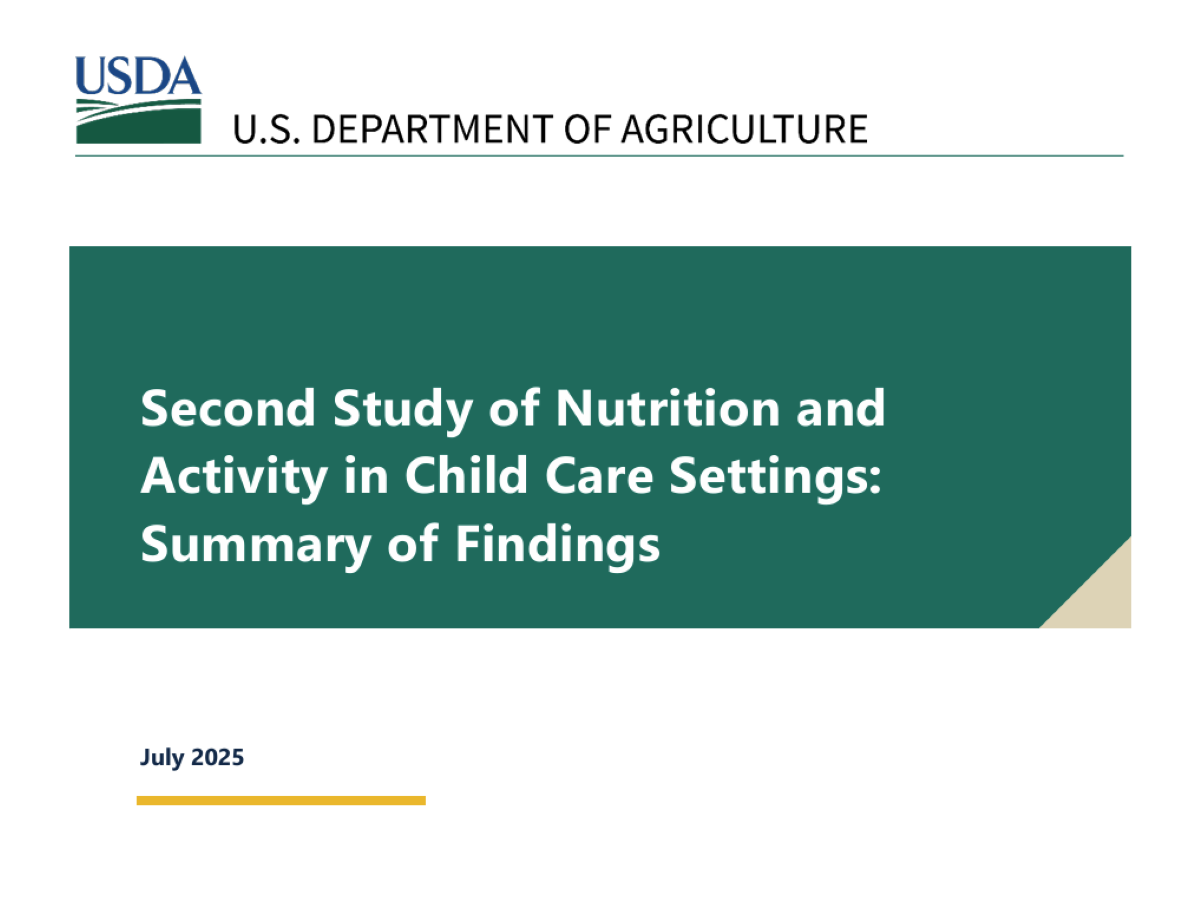Second Study of Nutrition and Activity in CACFP
July 8, 2025

USDA released their second report on the Study of Nutrition and Activity in Child Care Settings (SNACS-II), which follow their first in 2022. SNACS-II uses data from program year 2022-23 to assess how well children’s diets and CACFP meals align with the Dietary Guidelines for Americans. Data was collected on:
- Policies and practices of child care programs participating in the Child and Adult Care Food Program (CACFP)
- Opportunities for physical activity in CACFP programs
- Nutritional quality of meals and snacks served in CACFP programs
- Cost and revenues of CACFP meals and snacks
- Child and family characteristics of participants (including children’s weight status)
- Child dietary intakes and plate waste
- Infant wellness and feeding policies and practices
- Comparisons of select outcomes with findings from SNACS-I
Why it Matters
CACFP operators have an opportunity to support healthy behaviors among young children through the meals they serve and the food and wellness environments they provide. Furthermore, CACFP policies and practices can help promote good early dietary habits and have the potential to affect the well-being of all children in their care. The data collated in the SNACS II report can be used to identify areas of CACFP that are lacking, in order to provide solutions to enhance program success. In addition, the report highlights the great work being done by CACFP operators, as well as the importance of CACFP in promoting nutrition security.
Children’s Diets Better in CACFP Child Care
- 3- to 5-year-old children had better overall diets on days when they attended child care than on days when they did not attend.
- On days in child care, 3- to 5-year-olds consumed more vegetables, fruit, whole grains, and dairy compared to days not in child care. They also consumed fewer calories from saturated fats and added sugars.
- On average, 3- to 5-year-olds consumed 37% of their calories on child care days from CACFP meals and snacks.
Infant Wellness
- 88% of full-day child cares with infants reported offering supervised tummy time for infants at least once per day, as did 86% of half-day child cares.
- T31% of child cares met the AAP recommendation for the timing of introduction of solid foods.
- Overall, 72% of infants consumed only formula while in child care on the single data collection day, 18% consumed only breast milk, and 2% consumed a combination of formula and breast milk.
CACFP Providers Serve Meals and Snacks that are DGA-Aligned
- Most early child care programs served all the required meal components to 3- to 5-year-olds.
- Nearly all early child care programs (99%) also met the requirement to limit fruit juice.
- Most before and afterschool programs served all the required meal components.
- For children ages 3 to 5 years in early child care programs, Healthy Eating Index(HEI) scores for breakfasts and lunches increased from SNACS-I to SNACS-II. The HEI total score for all meals and snacks combined for this age group rose from 72 in SNACS-I to 77 in SNACS-II.
- For children ages 3 to 5 years in early child care programs, HEI scores for breakfasts and lunches increased from SNACS-I to SNACS-II. The HEI total score for all meals and snacks combined for this age group rose from 72 in SNACS-I to 77 in SNACS-II.
Plate Waste
- At breakfast served to 3- to 5-year-olds, foods most often wasted were fruits (37%), grains (35%), and combination entrees (43%).
- At lunch, foods most often wasted were vegetables (55%), combination entrees (36%), and meats/meat alternates (35%).
- From snacks, almost half of vegetables (49%) and about one-third each of meats/meat alternates (32%) and fruits (29%) were wasted.
Opportunities for Physical Activity
- Children had an average of four physical activity sessions per day at a given provider—three outdoors and one indoors (adjusted for an 8-hour day).
Reimbursement Rates Don’t Cover Meal Costs
- Among child care and Head Start centers, the mean total cost per meal, which includes both food and labor costs, was $8.80 for breakfast, $9.70 for lunch, and $6.30 for snack.
- On average, labor costs accounted for 77% of total breakfast costs, 67% of total lunch costs, and 81% of total snack costs.
- On average, reimbursement rates covered 26% of total breakfast costs, 35% of total lunch costs, and 21% of total snack costs.
Comparison to SNACS-I
- The three most common provider-reported challenges to participating in CACFP were the same in both time periods: (1) meal reimbursement not covering food expenses, (2) lack of children eligible for higher reimbursement, and (3) meal reimbursement paperwork.
- Children participated in more physical activity in SNACS-II than in SNACS-I. Adjusted for an 8-hour day, children in child care in PY 2022–2023 were observed doing physical activity for nearly a half hour more (123 minutes versus 96 minutes than in PY 2016–2017).
- Mean total HEI-2015 scores for breakfasts, lunches, and all meals and snacks combined that were served to 3- to 5-year-olds in child care were statistically significantly higher in SNACS-II. All meals and snacks combined had a mean HEI-score of 77 in SNACS-II, compared to a mean score of 72 in SNACS-I.
For more details, read the Second Study of Nutrition and Activity in Childcare Settings (SNACS-II).
